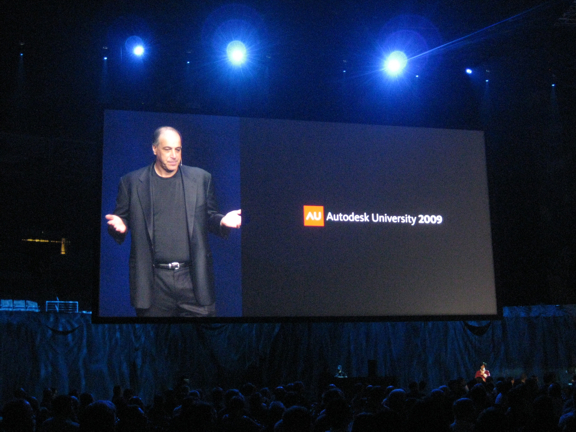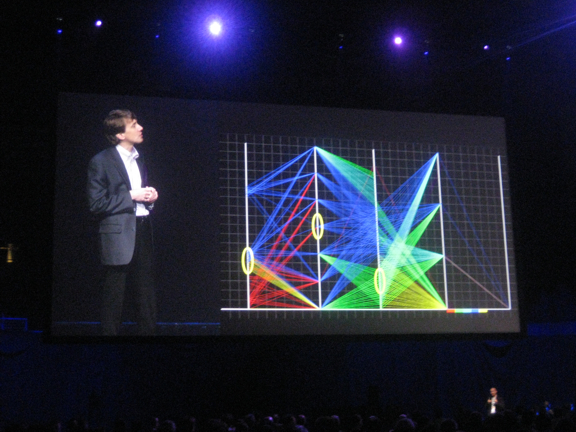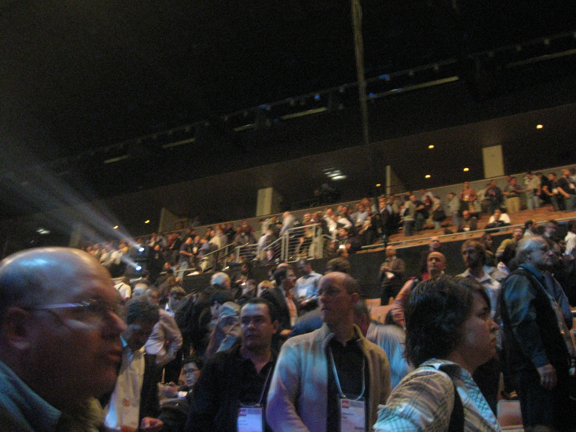Latest News
December 2, 2009

Greetings from Mandalay Bay, home of Autodesk University 2009!
The arena, the indoor amphitheater where Autodesk CEO and president Carl Bass delivered his opening speech, was designed to seat 12,000. The venue could easily accommodate the estimated 6,000 attendees who streamed through its doors, with generous room to spare. But it would have been too small for Autodesk University (AU) Virtual, the Web-cast version of the event the company began offering this year. Boasting a roster of 16,000, the virtual audience was nearly three times the onsite crowd.
The tough economy might explain part of the appeal of AU Virtual. Those who came to the conference in person had spent roughly $2,400 each on the pass alone, with airfare and hotel bill on top of that. On the other hand, AU Virtual passes are free. For $99, you can get an AU Virtual Premiere pass, which allows you to tune into 60 live-streaming classes and watch up to 350 on-demand classes. (For a detailed comparison of AU and AU Virtual benefits, see this chart.) All you need to attend AU Virtual is a Web browser.
“In the future, your real world will be much more virtual, your virtual world will be much more real, and the future is coming faster than you think,” predicted Autodesk CTO Jeff Kowalski.


3D CAD’s Future in a Browser WindowThe virtual space, or cloud in networking lingo, can offer a number of computing benefits, Bass pointed out. CAD on cloud ranges from a classic desktop application running on a remote server, accessible via a thin client, to an application written specifically for the Web, running on a server, with multiple users accessing it using the browser as client.
Project Twitch, currently available at Autodesk Labs, serves as an example of the first kind. By downloading and installing a small client application (roughly 7 MB), you can begin running Autodesk Inventor 2010, AutoCAD 2010, and Autodesk Revit Architecture 2010 online—without downloading and installing the chosen software in your own machine. (For more on Twitch, read “Autodesk Twitching in the Cloud,” September 21, 2009.)
On the other end of the spectrum are technology previews like Project Showroom, an architecture rendering program, and Project Dragonfly, a floor-plan design program, both available as browser-based applications in Autodesk Labs. Though they’re targeted at architecture, construction, and interior design markets, nothing would prevent Autodesk from developing similar applications for manufacturing and industrial design customers.
Brian Mathews, VP of platform solutions and emerging businesses for Autodesk Labs, revealed, “Currently, we view [Project Twitch] as a way to let people try out our software.”
Conventional method of trying out Autodesk Inventor requires you to submit a request online, then wait 2-3 weeks for a 30-day trial DVD in the mail. If you’re willing to settle for Autodesk Inventor LT, you could immediately download the installation code, a hefty 1.3 GB file. By comparison, Project Twitch lets you immediately launch Autodesk Inventor and begin modeling over an Internet connection.
But delivering a full-fledged desktop CAD application like Inventor over the Web is not easy. It requires significant back-end IT infrastructure to accommodate simultaneous users, located in different geographic regions. For this reason, Autodesk currently restricts Project Twitch to within 1,000 miles from the data center (located in Santa Clara, California), to users with 5MB connection or faster, equipped with 1.6 GHz or higher dual-core CPU and 1 GB RAM.
Project Twitch proves Web-based CAD is possible, but, during a Q&A session with the media, Bass revealed, “I don’t see Autodesk going into the [computing] infrastructure business.” That indicates Autodesk would need reliable data-warehousing and IT infrastructure partners if it intends to offer Web-based licensing options for its computing-intensive titles. While users may be willing to tolerate limited performance and functions (like only being able to open preloaded files, as it is currently the case with titles in Project Twitch) in a software trial, they’ll expect to be able to run the full program with performance that rivals desktop applications if they’re paying for it.
Remote Rendering
Another way to take advantage of the Web-based model, Bass suggested, is to use it for computing tasks that may be too demanding for a typical desktop or laptop CPU. “That could be anything from rendering and animation to simulation,” he said.
Because cloud computing allows you to use the computing power of a remote machine, you could in fact be rendering a scene on a remote GPU or CPU with capacities that far supersede your own machine’s limitations. “Wouldn’t it be great if, instead of running a Moldflow calculation [for simulating injection molding process] that takes 24 hours, I could run a hundred Moldflow calculations in a matter of an hour?” Bass conjectured.
While Autodesk remains dedicated to developing and delivering professional-grade products, the apparent ease of use in many of its latest technology previews (Showroom, Dragonfly, and Cooper, to name but a few) suggests the company is also branching out and catering to the casual 3D market.
What About Mac?“We see a phenomemal amount of Apple hardware, running Windows applications. I think many people would like to be able to do it natively [that is, use Apple hardware to run 3D modeling and rendering apps written for Apple OS],” said Bass.
After R12, Autodesk turned its back on Apple, developing the product exclusively for Windows for the better part of the next two decades. But this April, Autodesk begin conducting a survey titled AutoCAD for Apple Mac, raising hopes that Autodesk’s flagship drafting and drawing program might return to the Mac platform. In the same month, Autodesk’s rival Siemens PLM Software released its flagship mechanical CAD package NX for Mac.
The AutoCAD on Mac survey was preceded by the relese of Autodesk Alias 2010 for Mac in February 2009. Since the software was previously only available for Windows, the new release could be seen as proof of the company’s renewed interest in Apple.
Under the cloud cocomputing model, Autodesk could accommodate both Windows and Mac users, because applications written specifically to run in a browser window tend to be operating system-agnostic.
Unanticipated BenefitsAutodesk and most business software merchants rely on the notion that software is licensed, not sold. Under this policy, and indeed under most software licensing agreements, software users are not permitted to transfer the right to the software. But this long-held tradition was challenged when a judge recently ruled that an eBay reseller could legally resell the secondhand copies of AutoCAD he’d acquired. (For more, read, “Software Resale on eBay: Cout Sided with Reseller,” October 13, 2009.)
Because Web-based software licensing doesn’t involve an installation CD or DVD (a transferrable physical media), it makes the sale of secondhand software essentially an irrevelent issue.
Green product advocates may also find cloud computing a better delivery model for the environment, as the process doesn’t generate the usual material waste that comes from packaging and shipping.
Amory Lovins, chairman, cofounder, and chief scientist or Rocky Mountain Institute, shared the stage with Bass during the keynote event. Citing Ray C. Anderson, often praised as a radical industrialist, Lovins encouraged designers to consider products that “takes nothing, wastes nothing, and does no harm.”
Cloud computing certainly seems to take less hard disk space, waste less computing power, and do less harm to the operating system.
For more, read Part II and watch the video report below:
Subscribe to our FREE magazine, FREE email newsletters or both!
Latest News
About the Author
Kenneth Wong is Digital Engineering’s resident blogger and senior editor. Email him at [email protected] or share your thoughts on this article at digitaleng.news/facebook.
Follow DE





